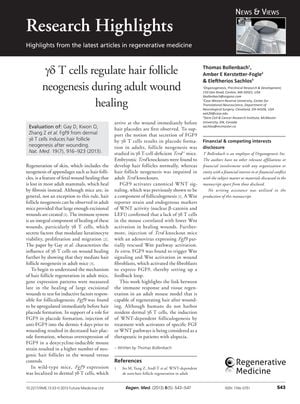Research Highlights: Gamma Delta T Cells Regulate Hair Follicle Neogenesis During Adult Wound Healing
September 2013
in “
Regenerative Medicine
”
γδ T cells hair follicle neogenesis wound healing Fgf9 hair placode formation WNT activation folliculogenesis adenovirus Tcrd knockout mice alopecia FGF pathway WNT pathway hyaluronan hyaluronidase CD44-NF2 pathway hair follicle regeneration hair growth fibroblast growth factor 9 WNT signaling hair follicle development fibroblast growth factor WNT signaling pathway high-molecular-mass hyaluronan hyaluronic acid CD44

TLDR γδ T cells help with hair growth during wound healing in mice.
The document highlights a study by Gay et al. on the role of γδ T cells in hair follicle neogenesis during adult wound healing in mice. The study demonstrated that γδ T cells express Fgf9, which is crucial for hair placode formation. Blocking FGF9 reduced hair placode formation, while its overexpression increased neogenic hair follicles. Mice lacking γδ T cells showed impaired hair follicle neogenesis in adults, but not in embryos. The absence of γδ T cells also led to reduced WNT activation, which is essential for folliculogenesis. Introducing Fgf9 via an adenovirus to Tcrd knockout mice partially restored Wnt pathway activation. The findings suggest a potential therapeutic approach for alopecia by targeting FGF or WNT pathways, although humans do not have resident dermal γδ T cells. The document also discusses the role of high-molecular-mass hyaluronan (HMM-HA) in cancer resistance in naked mole rats, where reduced secretion of hyaluronidase leads to HMM-HA accumulation and extended contact inhibition, regulated by the CD44-NF2 pathway. Altering HMM-HA levels in naked mole rat fibroblasts resulted in tumor formation in immunodeficient mice, indicating a potential anticancer mechanism. Further research is suggested to explore the benefits for human health. Specific numbers of mice used in the study were not provided.






